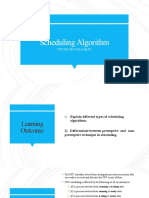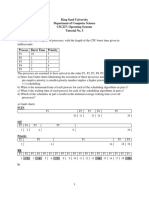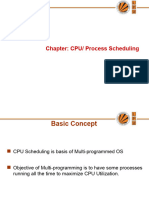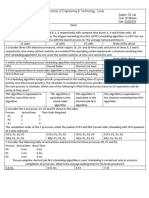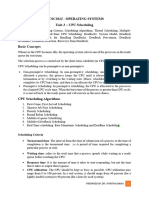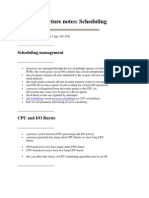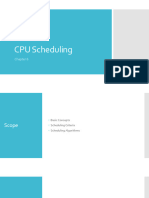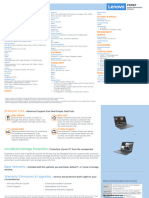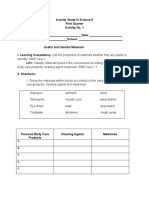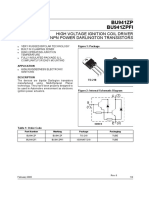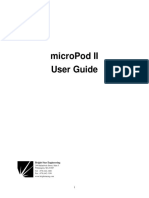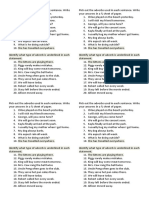Operating Systems (202040402)
Assignment-2
Submission Date:
Sr No Learning
Questions CO
Level
1
1. What is the difference between busy waiting and
blocking in mutual exclusion?
2. How does Peterson’s Algorithm ensure mutual exclusion
between two processes?
3. Which mutual exclusion mechanism is NOT suitable for
multiprocessor systems?
4. Consider a semaphore S = 3. If 5 processes try to enter
the critical section simultaneously, how many will be
blocked?
5. In a producer-consumer problem, how can you
implement IPC using semaphores?
6. What are the four necessary conditions of a critical
section problem?
7. How do mutex locks prevent race conditions?
2
1. Consider the following set of processes with their arrival
and burst times:
Process Arrival Time Burst Time
P1 0 5
P2 1 3
P3 2 8
P4 3 6
Find the average waiting time and average turnaround time
using FCFS scheduling, Shortest Job Next (SJN) scheduling
(non-preemptive).
with a time quantum of 2 units.Find the average waiting time
and average turnaround time using Round Robin (RR)
scheduling.
2. Consider the following set of processes with priorities:
Process Arrival Time Burst Time Priority
P1 0 6 3
P2 1 8 1
P3 2 7 4
P4 3 3 2
Compute the average waiting time and average turnaround
time using Priority Scheduling (preemptive & non-preemptive).
3. Consider the following set of processes:
Process Arrival Time Burst Time
P1 0 10
P2 1 5
P3 2 8
P4 3 4
Find the following using First-Come, First-Served (FCFS)
Scheduling
Completion Time (CT)
Turnaround Time (TAT)
Waiting Time (WT)
Average Turnaround Time
Average Waiting Time
4. Consider the following processes scheduled using SJF
(Non-Preemptive):
Process Arrival Time Burst Time
P1 0 7
P2 2 4
P3 4 1
P4 5 3
Find:
Completion Time (CT)
Turnaround Time (TAT)
Waiting Time (WT)
Average TAT and WT
5. A system has the following processes scheduled using
Shortest Remaining Time First (SRTF) - Preemptive Scheduling
Process Arrival Time Burst Time
P1 0 8
P2 1 4
P3 2 9
P4 3 5
Calculate Completion Time (CT), Turnaround Time (TAT), and
Waiting Time (WT) using Shortest Remaining Time First
(SRTF) scheduling.
Compute the average turnaround time and average waiting
time.
6. Multi-Level Queue (MLQ) Scheduling
A system uses Multilevel Queue Scheduling with two queues:
Queue 1 (Foreground): Uses Round Robin (Time Quantum = 3
ms)
Queue 2 (Background): Uses FCFS
Given processes:
Process Arrival Time Burst Time Queue
P1 0 7 1
P2 2 4 2
P3 4 5 1
P4 5 2 2
Compute Completion Time (CT), Turnaround Time (TAT), and
Waiting Time (WT).
Draw the Gantt Chart.
Compute average turnaround time and average waiting time.
3
1. What are the differences between preemptive and
non-preemptive scheduling?
2. Explain priority inversion and how it can be resolved.
3. What is CPU-I/O burst cycle, and how does it affect
scheduling decisions?
4. Explain convoy effect in FCFS scheduling.
5. What are the advantages and disadvantages of
multilevel queue scheduling?
6. Compare Round Robin (RR) scheduling with Multilevel
Feedback Queue (MLFQ).
How does aging help in reducing starvation in scheduling?
What is the difference between short-term, long-term, and
medium-term scheduling?
What are the conditions under which priority scheduling leads
to starvation?
Explain the effect of time quantum in Round Robin scheduling.
What is the role of the Dispatcher in process scheduling?
Compare FIFO, Round Robin, and Shortest Remaining Time
First (SRTF) scheduling.
What are the conditions under which deadlock can occur due to
scheduling?










